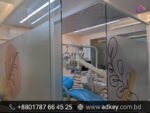






Hospital Glass Vinyl Sticker Print and Lamination
Window or glass stickers are commonly seen in malls, offices or even homes. Some stickers act as a privacy film or some even as an advertising tool for shopping retails and offices to market their products or services.
Stickers can be be different forms
1. Vinyl Die Cut
2. Printed
3. Frosted
adkey Limited! Shopping Events
Sale_coupon_15
115.00৳ Original price was: 115.00৳ .65.00৳ Current price is: 65.00৳ .This price is applicable for minimum 25 per square feet
-
Pick up from the adkey Limited
To pick up today
-
Courier delivery
Our courier will deliver to the specified address
2-3 Days
-
DHL Courier delivery
DHL courier will deliver to the specified address
2-3 Days
-
3 Years Warranty of Free Services with Materials.
Payment Methods:
Description
Hospital Glass Vinyl Sticker Print and Lamination: A Comprehensive Guide
Hospitals rely heavily on effective signage. In fact, studies show that clear and accessible signage can reduce patient confusion by over 30%. Hospital glass vinyl stickers serve as an essential tool for navigation, safety, and communication within medical facilities. These stickers need to withstand frequent cleaning and harsh conditions, which is where lamination becomes vital. Hospital Glass
Choosing the Right Vinyl for Hospital Environments
Material Considerations
Selecting the right vinyl is crucial for any hospital application. Here’s a comparison of popular types:
| Vinyl Type | Durability | Cost | Best Uses |
|---|---|---|---|
| Monomeric | Moderate | Low | Indoor Signage |
| Polymeric | High | Medium | Indoor & Outdoor Signage |
| Cast | Very High | High | Long-term Applications |
Durability and Cleanability
Vinyl must endure regular cleaning with sanitizing agents. Monomeric vinyl can wear out faster under frequent cleaning. In contrast, polymeric and cast vinyl are designed to resist chemicals, making them better suited for hospital use.
Adhesion and Application
Proper adhesion to glass surfaces is crucial. Use a squeegee to remove air bubbles during application. Ensure the glass is clean for a strong bond, vital in sterile environments.
Design and Printing Considerations for Hospital Signage
Legibility and Compliance
Hospital signage must be easy to read. Follow ADA guidelines to ensure that all messages are clear. Successful examples include directional signs and safety notices that use straightforward language and typography.
Color and Branding
Color plays a significant role in hospital design. Warm tones can create a calming environment while promoting brand consistency. Research has shown that the right colors can positively influence patient perceptions.
Printing Techniques and Resolution
Different printing methods impact the quality of signage. Inkjet printing allows for high resolution and vibrant colors, while screen printing is excellent for larger runs. Each method has its pros and cons regarding durability and expense.
Lamination: Protecting Your Hospital Signage Investment
Types of Lamination
Laminating your stickers protects them from damage. Options include:
- Gloss: Enhances color vibrancy but may cause glare.
- Matte: Reduces glare and offers a soft finish.
- Anti-graffiti: Makes cleaning easier and resists damage from markers and stickers.
Benefits of Lamination for Durability
Laminated signage lasts longer. It resists scratches, fading, and chemical exposure, ensuring your signage remains clear and effective. For example, hospitals that use laminated signs have noted their signs last years longer than unlaminated counterparts.
Lamination and Infection Control
Laminated surfaces simplify cleaning and disinfecting, which is crucial in preventing the spread of infections. A study found that laminated signs could be sanitized more effectively than non-laminated options.
Installation and Maintenance of Hospital Vinyl Stickers
Proper Installation Techniques
To install vinyl stickers on glass:
- Measure and mark the placement.
- Clean the surface thoroughly.
- Peel the backing slightly and position the sticker.
- Use a squeegee to press the vinyl, smoothing out air bubbles.
- Carefully peel off the transfer tape.
Cleaning and Sanitizing Procedures
Proper cleaning keeps your signage looking new. Use a microfiber cloth with mild soap and water. Avoid abrasive cleaners that can scratch the surface.
Troubleshooting Common Issues
If you encounter air bubbles, use a pin to poke them gently and push air out. For misalignment, remove and reposition the sticker. Take care not to stretch the vinyl.
Cost-Effectiveness and Long-Term Benefits
Return on Investment (ROI)
Investing in quality signage pays off. Durable signage reduces replacement costs. For instance, if quality signage lasts five years compared to cheaper options that need replacing every year, you save on material costs and labor.
Brand Consistency and Patient Experience
Consistent signage enhances a hospital’s reputation. Well-maintained signs reassure patients and improve their overall experience, making navigation easier and less stressful.
Compliance and Risk Mitigation
Proper signage ensures that hospitals meet regulations, reducing the risk of accidents. This attention to detail protects both patients and staff.
Conclusion
Choosing high-quality materials, expert installation, and regular maintenance are vital for hospital signage. From selecting the right vinyl to understanding lamination benefits, every detail matters. Invest in your hospital’s signage to improve patient experience and ensure compliance. For personalized assistance, consider contacting a professional to discuss your hospital’s needs.
Specification
 LED Sign Board
LED Sign Board
 Neon Sign
Neon Sign
 Name Plate
Name Plate
 Digital Print
Digital Print
 Billboard
Billboard
 LED Module Light
LED Module Light
 Rainproof Power Supply
Rainproof Power Supply
 Shop Sign
Shop Sign
 Safety Sign
Safety Sign
 General
General
Customer Reviews
Related Products
LED Sign Board Maker By adkey Limited in Dhaka Bangladesh
In stock
3D Acrylic LED and Metal Signage Price BD
In stock
3D Acrylic High Letter LED Sign Board
In stock
3D Acrylic LED Sign Board
In stock
Acrylic Sign Board price in Dhaka Bangladesh
In stock
3D Acrylic LED Letter Glow Sign Boards
In stock



















Reviews
Clear filtersThere are no reviews yet.